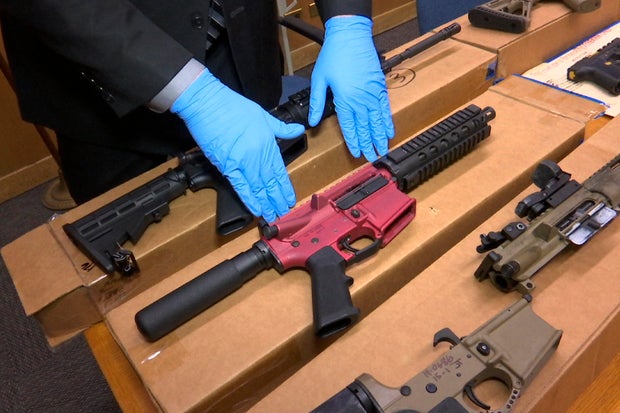Washington — The Supreme Court on Tuesday will convene to hear arguments Tuesday over the Biden administration’s efforts to regulate unserialized firearms called ghost guns, considering for the second time in a matter of months whether the Bureau of Alcohol, Tobacco, Firearms and Tobacco went too far when it took unilateral action to curb gun violence.
Brought by a group of firearms owners, gun rights groups and manufacturers, the challengers are seeking to invalidate the regulation that seeks to subject ghost guns to the same requirements as commercially made firearms.
But the Biden administration has warned that striking down the rule would give criminals, minors and others who are legally barred from having guns access to kits that can be assembled into a functioning, untraceable firearm in less than 30 minutes.
The question in the case, known as Garland v. VanDerStok, isn’t whether Second Amendment rights were violated, but whether the ATF exceeded its authority when it issued the regulation in 2022. The rule clarified the definition of “firearm” in the Gun Control Act of 1968 to include a weapon parts kit that can be assembled into an operational firearm, and the incomplete frame of a handgun and receiver of a rifle.
The measure aims to address a surge in crimes committed using ghost guns, which can be made from 3D printers or kits and parts available online. Because these firearms don’t have serial numbers or transfer records, it’s difficult for law enforcement to trace them to their buyers, making them especially attractive to people who can’t legally buy firearms or plan to use them in crimes.
Haven Daley / AP
But by clarifying the definition of “firearm” in the Gun Control Act to cover these kits, the manufacturers and sellers of ghost guns must be licensed, mark their products with serial numbers, run background checks on prospective buyers and maintain transfer records, all things commercial gun makers must do.
A group of 20 major cities told the Supreme Court in a filing that the rule appears to have been effective at reducing the use of ghost guns in their municipalities and around the country. In New York, for example, ghost gun recoveries dropped last year for the first time in four years. In Baltimore, they decreased in 2023 for the first time since 2019.
The gun owners, advocacy groups and kit manufacturers sued the Biden administration over the rule shortly after it took effect, arguing that when Congress wrote the 1968 law, it didn’t give the ATF the power to change the definition of firearm to cover kits. A federal district court judge invalidated the regulation. A panel of three judges on the U.S. Court of Appeals for the 5th Circuit also struck down the regulation, finding that only finished firearms, or complete frames or receivers, are covered by the Gun Control Act.
The Biden administration then asked the Supreme Court to review that decision, arguing that the rule just ensures that ghost guns comply with the same “straightforward and inexpensive administrative requirements” that apply to commercial firearms sales.
The 5th Circuit’s decision, Solicitor General Elizabeth Prelogar wrote, “ignores the words Congress wrote and would effectively nullify the act’s careful regulatory scheme by allowing anyone to anonymously buy a kit online and assemble a fully functional gun in minutes — no background check, records, or serial number required.”
She also argued that the lower court’s interpretation of the law frustrates its design by transforming the definition of firearm into an invitation to evade its requirements.
But the challengers said the ATF’s clarification cannot be reconciled with the plain text of the Gun Control Act and “risks upending the regulation of popular semiautomatic firearms.”
They told the high court in a filing that any change in the regulatory approach to privately made firearms must come from Congress, not the ATF.
“The decisive fact in this case is Congress’s decision, in the GCA, to focus on the commercial firearm market rather than the private making of firearms for personal use. Accordingly, the GCA does not reach the items used in private firearm making that ATF attempts to regulate,” the gun owners, led by Jennifer VanDerStok of Texas, said.
The Supreme Court has been asked to intervene in the legal dispute before, but in an earlier stage in the litigation. In August 2023, the high court agreed to allow the Biden administration to enforce the ghost gun rule until it issues a decision on its legality, likely by the end of June 2025.
The Supreme Court divided 5-4 in halting the district court order that struck down the measure, with Chief Justice John Roberts and Justice Amy Coney Barrett joining the three liberal justices in the majority.
Roberts and Barrett’s earlier votes make them key justices to watch, though they do not mean they’ll vote to uphold the measure now that the Supreme Court is considering the merits of the case.
The high court will consider the ghost gun rule just months after it invalidated a separate measure that banned bump stocks, a firearms accessory that increases a semi-automatic rifle’s rate of fire to hundreds of rounds per minute.
In striking down the rule, the Supreme Court’s six-justice conservative majority ruled the ATF exceeded its authority when it issued the ban in 2018 after a mass shooting at a music festival in Las Vegas, the deadliest in U.S. history.


